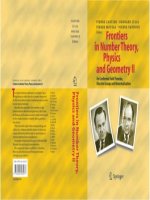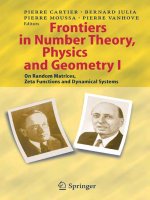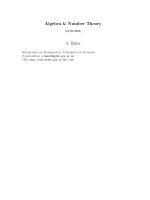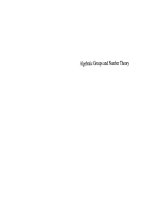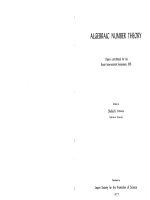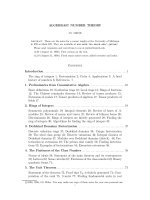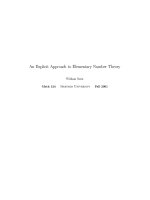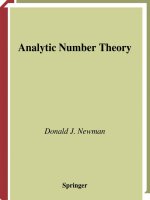elementary number theory notes - santos
Bạn đang xem bản rút gọn của tài liệu. Xem và tải ngay bản đầy đủ của tài liệu tại đây (907.82 KB, 183 trang )
Elementary Number Theory Notes
c
David A. Santos
January 15, 2004
ii
Contents
Preface v
1 Preliminaries 1
1.1 Introduction . . . . . . . . . . . . . . . . . . . . . . . . . . 1
1.2 Well-Ordering . . . . . . . . . . . . . . . . . . . . . . . . . 2
1.3 Mathematical Induction . . . . . . . . . . . . . . . . . . . 4
1.4 Binomial Coefficients . . . . . . . . . . . . . . . . . . . . . 16
1.5 Vi
`
ete’s Formulæ . . . . . . . . . . . . . . . . . . . . . . . 16
1.6 Fibonacci Numbers . . . . . . . . . . . . . . . . . . . . . 16
1.7 Pigeonhole Principle . . . . . . . . . . . . . . . . . . . . . 23
2 Divisibility 31
2.1 Divisibility . . . . . . . . . . . . . . . . . . . . . . . . . . . . 31
2.2 Division Algorithm . . . . . . . . . . . . . . . . . . . . . . . 34
2.3 Some Algebraic Identities . . . . . . . . . . . . . . . . . . 38
3 Congruences. Z
n
47
3.1 Congruences . . . . . . . . . . . . . . . . . . . . . . . . . 47
3.2 Divisibility Tests . . . . . . . . . . . . . . . . . . . . . . . . . 57
3.3 Complete Residues . . . . . . . . . . . . . . . . . . . . . . 60
4 Unique Factorisation 63
4.1 GCD and LCM . . . . . . . . . . . . . . . . . . . . . . . . 63
4.2 Primes . . . . . . . . . . . . . . . . . . . . . . . . . . . . . . 73
4.3 Fundamental Theorem of Arithmetic . . . . . . . . . . . 76
iii
iv CONTENTS
5 Linear Diophantine Equations 89
5.1 Euclidean Algorithm . . . . . . . . . . . . . . . . . . . . . 89
5.2 Linear Congruences . . . . . . . . . . . . . . . . . . . . . 94
5.3 A theorem of Frobenius . . . . . . . . . . . . . . . . . . . 96
5.4 Chinese Remainder Theorem . . . . . . . . . . . . . . . . 100
6 Number-Theoretic Functions 105
6.1 Greatest Integer Function . . . . . . . . . . . . . . . . . . 105
6.2 De Polignac’s Formula . . . . . . . . . . . . . . . . . . . . 116
6.3 Complementary Sequences . . . . . . . . . . . . . . . . 119
6.4 Arithmetic Functions . . . . . . . . . . . . . . . . . . . . . 121
6.5 Euler’s Function. Reduced Residues . . . . . . . . . . . . 128
6.6 Multiplication in Z
n
. . . . . . . . . . . . . . . . . . . . . . 134
6.7 M
¨
obius Function . . . . . . . . . . . . . . . . . . . . . . . 138
7 More on Congruences 141
7.1 Theorems of Fermat and Wilson . . . . . . . . . . . . . . 141
7.2 Euler’s Theorem . . . . . . . . . . . . . . . . . . . . . . . . 147
8 Scales of Notation 151
8.1 The Decimal Scale . . . . . . . . . . . . . . . . . . . . . . 151
8.2 Non-decimal Scales . . . . . . . . . . . . . . . . . . . . . 157
8.3 A theorem of Kummer . . . . . . . . . . . . . . . . . . . . 161
9 Diophantine Equations 165
9.1 Miscellaneous Diophantine equations . . . . . . . . . . 165
10 Miscellaneous Examples and Problems 169
10.1 Miscellaneous Examples . . . . . . . . . . . . . . . . . . . 170
11 Polynomial Congruences 173
12 Quadratic Reciprocity 175
13 Continued Fractions 177
Preface
These notes started in the summer of 1993 when I was teaching
Number Theory at the Center for Talented Youth Summer Program
at the Johns Hopkins University. The pupils were between 13 and 16
years of age.
The purpose of the course was to familiarise the pupils with contest-
type problem solving. Thus the majority of the problems are taken
from well-known competitions:
AHSME American High School Mathematics Examination
AIME American Invitational Mathematics Examination
USAMO United States Mathematical Olympiad
IMO International Mathematical Olympiad
ITT International Tournament of Towns
MMPC Michigan Mathematics Prize Competition
(UM)
2
University of Michigan Mathematics Competition
STANFORD Stanford Mathematics Competition
MANDELBROT Mandelbrot Competition
Firstly, I would like to thank the pioneers in that course: Samuel
Chong, Nikhil Garg, Matthew Harris, Ryan Hoegg, Masha Sapper,
Andrew Trister, Nathaniel Wise and Andrew Wong. I would also like
to thank the victims of the summer 1994: Karen Acquista, Howard
Bernstein, Geoffrey Cook, Hobart Lee, Nathan Lutchansky, David
Ripley, Eduardo Rozo, and Victor Yang.
I would like to thank Eric Friedman for helping me with the typing,
and Carlos Murillo for proofreading the notes.
Due to time constraints, these notes are rather sketchy. Most of
v
vi CONTENTS
the motivation was done in the classroom, in the notes I presented a
rather terse account of the solutions. I hope some day to be able to
give more coherence to these notes. No theme requires the knowl-
edge of Calculus here, but some of the solutions given use it here
and there. The reader not knowing Calculus can skip these prob-
lems. Since the material is geared to High School students (talented
ones, though) I assume very little mathematical knowledge beyond
Algebra and Trigonometry. Here and there some of the problems
might use certain properties of the complex numbers.
A note on the topic selection. I tried to cover most Number The-
ory that is useful in contests. I also wrote notes (which I have not
transcribed) dealing with primitive roots, quadratic reciprocity, dio-
phantine equations, and the geometry of numbers. I shall finish writ-
ing them when laziness leaves my weary soul.
I would be very glad to hear any comments, and please forward
me any corrections or remarks on the material herein.
David A. Santos
Chapter 1
Preliminaries
1.1 Introduction
We can say that no history of mankind would ever be complete
without a history of Mathematics. For ages numbers have fasci-
nated Man, who has been drawn to them either for their utility at
solving practical problems (like those of measuring, counting sheep,
etc.) or as a fountain of solace.
Number Theory is one of the oldest and most beautiful branches
of Mathematics. It abounds in problems that yet simple to state, are
very hard to solve. Some number-theoretic problems that are yet
unsolved are:
1. (Goldbach’s Conjecture) Is every even integer greater than 2
the sum of distinct primes?
2. (Twin Prime Problem) Are there infinitely many primes p such
that p + 2 is also a prime?
3. Are there infinitely many primes that are 1 more than the square
of an integer?
4. Is there always a prime between two consecutive squares of
integers?
In this chapter we cover some preliminary tools we need before
embarking into the core of Number Theory.
1
2 Chapter 1
1.2 Well-Ordering
The set N = {0, 1, 2, 3, 4, . . .} of natural numbers is endowed with two
operations, addition and multiplication, that satisfy the following prop-
erties for natural numbers a, b, and c:
1. Closure: a + b and ab are also natural numbers.
2. Associative laws: (a + b) + c = a + (b + c) and a(bc) = (ab)c.
3. Distributive law: a(b + c) = ab + ac.
4. Additive Identity: 0 + a = a + 0 = a
5. Multiplicative Identity: 1a = a1 = a.
One further property of the natural numbers is the following.
1 Axiom Well-Ordering Axiom Every non-empty subset S of the nat-
ural numbers has a least element.
As an example of the use of the Well-Ordering Axiom, let us prove
that there is no integer between 0 and 1.
2
Example Prove that there is no integer in the interval ]0; 1[.
Solution: Assume to the contrary that the set S of integer s in ]0; 1[ is
non-empty. Being a set of positive integers, it must contain a least
element, say m. Now, 0 < m
2
< m < 1, and so m
2
∈ S . But this is
saying that S has a positive integer m
2
which is smaller than its least
positive integer m. This is a contradiction and so S = ∅.
We denote the set of all integers by Z, i.e.,
Z = {. . . − 3, −2, −1, 0, 1, 2, 3, . . .}.
A rational number is a number which can be expressed as the ratio
a
b
of two integers a, b, where b = 0. We denote the set of rational
numbers by Q. An irrational number is a number which cannot be
expressed as the ratio of two integers. Let us give an example of an
irrational number.
Well-Ordering 3
3 Example Prove that
√
2 is irrational.
Solution: The proof is by contradiction. Suppose that
√
2 were ra-
tional, i.e., that
√
2 =
a
b
for some integers a, b. This implies that the
set
A = {n
√
2 : both n and n
√
2 positive integers}
is nonempty since it contains a. By Well-Ordering A has a smallest
element, say j = k
√
2. As
√
2 − 1 > 0,
j(
√
2 − 1) = j
√
2 − k
√
2 = (j − k)
√
2
is a positive integer. Since 2 < 2
√
2 implies 2 −
√
2 <
√
2 and also
j
√
2 = 2k, we see that
(j − k)
√
2 = k(2 −
√
2) < k(
√
2) = j.
Thus (j − k)
√
2 is a positive integer in A which is smaller than j. This
contradicts the choice of j as the smallest integer in A and hence,
finishes the proof.
4 Example Let a, b, c be integers such that a
6
+ 2b
6
= 4c
6
. Show that
a = b = c = 0.
Solution: Clearly we can restrict ourselves to nonnegative numbers.
Choose a triplet of nonnegative integers a, b, c satisfying this equa-
tion and with
max(a, b, c) > 0
as small as possible. If a
6
+ 2b
6
= 4c
6
then a must be even, a = 2a
1
.
This leads to 32a
6
1
+ b
6
= 2c
6
. Hence b = 2b
1
and so 16a
6
1
+ 32b
6
1
= c
6
.
This gives c = 2c
1
, and so a
6
1
+ 2b
6
1
= 4c
6
1
. But clearly max(a
1
, b
1
, c
1
) <
max(a, b, c). This means that all of these must be zero.
5 Example (IMO 1988) If a, b are positive integers such that
a
2
+ b
2
1 + ab
is
an integer, then
a
2
+ b
2
1 + ab
is a perfect square.
4 Chapter 1
Solution: Suppose that
a
2
+ b
2
1 + ab
= k is a counterexample of an integer
which is not a perfect square, with max(a, b) as small as possible. We
may assume without loss of generality that a < b for if a = b then
0 < k =
2a
2
a
2
+ 1
< 2,
which forces k = 1, a perfect square.
Now, a
2
+b
2
−k(ab+1) = 0 is a quadratic in b with sum of the roots
ka and product of the roots a
2
− k. Let b
1
, b be its roots, so b
1
+ b = ka
and b
1
b = a
2
− k.
As a, k are positive integers, supposing b
1
< 0 is incompatible with
a
2
+ b
2
1
= k(ab
1
+ 1). As k is not a perfect square, supposing b
1
= 0 is
incompatible with a
2
+ 0
2
= k(0 · a + 1). Also
b
1
=
a
2
− k
b
<
b
2
− k
b
< b.
Thus we have found another positive integer b
1
for which
a
2
+ b
2
1
1 + ab
1
= k
and which is smaller than the smallest max(a, b). This is a contradic-
tion. It must be the case, then, that k is a perfect square.
Ad Pleniorem Scientiam
6 APS Find all integer solutions of a
3
+ 2b
3
= 4c
3
.
7 APS Prove that the equality x
2
+ y
2
+ z
2
= 2xyz can hold for whole
numbers x, y, z only when x = y = z = 0.
1.3 Mathematical Induction
The Principle of Mathematical Induction is based on the following
fairly intuitive observation. Suppose that we are to perform a task
that involves a certain number of steps. Suppose that these steps
must be followed in strict numerical order. Finally, suppose that we
know how to perform the n-th task provided we have accomplished
Mathematical Induction 5
the n − 1-th task. Thus if we are ever able to start the job (that is , if
we have a base case), then we should be able to finish it (because
starting with the base case we go to the next case, and then to the
case following that, etc.).
Thus in the Principle of Mathematical Induction, we try to ver-
ify that some assertion P(n) concerning natural numbers is true for
some base case k
0
(usually k
0
= 1, but one of the examples below
shows that we may take, say k
0
= 33.) Then we try to settle whether
information on P(n − 1) leads to favou rable information on P(n).
We will now derive the Pr i nciple of Mathematical Induction from
the Well-Ordering Axiom.
8 Theorem Principle of Mathematical Induction If a setS of non-
negative integers contains the integer 0, and also contains the in-
teger n + 1 whenever it contains the integer n, then S = N.
Proof Assume this is not the case and so, by the Well-Ordering Prin-
ciple there exists a least positive integer k not in S . Observe that
k > 0, since 0 ∈ S and there is no positive integer smaller than 0. As
k − 1 < k, we see that k − 1 ∈ S . But by assumption k − 1 + 1 is also in
S , since the successor of each element in the set is also in the set.
Hence k = k − 1 + 1 is also in the set, a contradiction. Thus S = N. ❑
The following versions of the Principle of Mathematical Induction
should now be obvious.
9 Corollary If a set A of positive integer s contains the integer m and
also contains n + 1 whenever it contains n, where n > m, then A
contains all the positive integers greater than or equal to m.
10 Corollary Principle of Strong Mathematical Induction If a set A
of positive integers contains the integer m and also contains n +
1 whenever it contains m + 1, m + 2, . . . , n, where n > m, then A
contains all the positive integers greater than or equal to m.
We shall now give some examples of the use of induction.
6 Chapter 1
11 Example Prove that the expression
3
3n+3
− 26n − 27
is a multiple of 169 for all natural numbers n.
Solution: For n = 1 we are asserting that 3
6
− 53 = 676 = 169 · 4 is
divisible by 169, w hich is evident. Assume the assertion is true for
n − 1, n > 1, i.e., assume that
3
3n
− 26n − 1 = 169N
for some integer N. Then
3
3n+3
− 26n − 27 = 27 · 3
3n
− 26n − 27 = 27(3
3n
− 26n − 1) + 676n
which reduces to
27 · 1 69N + 169 · 4n,
which is divisible by 169. The assertion is thus established by induc-
tion.
12 Example Prove that
(1 +
√
2)
2n
+ (1 −
√
2)
2n
is an even integer and that
(1 +
√
2)
2n
− (1 −
√
2)
2n
= b
√
2
for some positive integer b, for all integers n ≥ 1.
Solution: We proceed by induction on n . Let P(n) be the proposition:
“(1 +
√
2)
2n
+ (1 −
√
2)
2n
is even and (1 +
√
2)
2n
− (1 −
√
2)
2n
= b
√
2 for
some b ∈ N.” If n = 1, then we see that
(1 +
√
2)
2
+ (1 −
√
2)
2
= 6,
an even integer, and
(1 +
√
2)
2
− (1 −
√
2)
2
= 4
√
2.
Mathematical Induction 7
Therefore P(1) is true. Assume that P(n − 1) is true for n > 1, i.e.,
assume that
(1 +
√
2)
2(n−1)
+ (1 −
√
2)
2(n−1)
= 2N
for some integer N and that
(1 +
√
2)
2(n−1)
− (1 −
√
2)
2(n−1)
= a
√
2
for some positive integer a.
Consider now the quantity
(1 +
√
2)
2n
+ (1 −
√
2)
2n
= (1 +
√
2)
2
(1 +
√
2)
2n−2
+ (1 −
√
2)
2
(1 −
√
2)
2n−2
.
This simplifies to
(3 + 2
√
2)(1 +
√
2)
2n−2
+ (3 − 2
√
2)(1 −
√
2)
2n−2
.
Using P(n − 1), the above simplifies to
12N + 2
√
2a
√
2 = 2(6N + 2a),
an even integer and similarly
(1 +
√
2)
2n
− (1 −
√
2)
2n
= 3a
√
2 + 2
√
2(2N) = (3a + 4N)
√
2,
and so P(n) is true. The assertion is thus established by induction.
13 Example Prove that if k is odd, then 2
n+2
divides
k
2
n
− 1
for all natural numbers n.
Solution: The statement is evident for n = 1, as k
2
− 1 = (k − 1)(k + 1) is
divisible by 8 for any odd natural number k because both (k−1) and
(k + 1) are divisible by 2 and one of them is divisible by 4. Assume
that 2
n+2
|k
2
n
− 1, and let us prove that 2
n+3
|k
2
n+1
− 1. As k
2
n+1
− 1 =
(k
2
n
− 1)(k
2
n
+ 1), we see that 2
n+2
divides (k
2n
− 1), so the problem
reduces to proving that 2|(k
2n
+ 1). This is obviously true since k
2n
odd
makes k
2n
+ 1 even.
8 Chapter 1
14 Example (USAMO 1978) An integer n will be called good if we
can write
n = a
1
+ a
2
+ ···+ a
k
,
where a
1
, a
2
, . . . , a
k
are positive integers (not necessarily distinct) sat-
isfying
1
a
1
+
1
a
2
+ ···+
1
a
k
= 1.
Given the information that the integer s 33 through 73 are good,
prove that every integer ≥ 33 is good.
Solution: We first prove that if n is good, then 2n + 8 and 2n + 9 are
good. For assume that n = a
1
+ a
2
+ ···+ a
k
, and
1 =
1
a
1
+
1
a
2
+ ··· +
1
a
k
.
Then 2n + 8 = 2a
1
+ 2a
2
+ ··· + 2a
k
+ 4 + 4 and
1
2a
1
+
1
2a
2
+ ··· +
1
2a
k
+
1
4
+
1
4
=
1
2
+
1
4
+
1
4
= 1.
Also, 2n + 9 = 2a
1
+ 2a
2
+ ···+ 2a
k
+ 3 + 6 and
1
2a
1
+
1
2a
2
+ ··· +
1
2a
k
+
1
3
+
1
6
=
1
2
+
1
3
+
1
6
= 1.
Therefore,
if n is good both 2n + 8 and 2n + 9 are good. (1.1)
We now establish the truth of the assertion of the problem by
induction on n. Let P(n) be the proposition “all the integers n, n +
1, n + 2, . . . , 2n + 7” are good. By the statement of the problem, we
see that P (33) is true. But (
1.1) implies the truth of P(n + 1) whenever
P(n) is true. The assertion is thus proved by induction.
We now present a variant of the Principle of Mathematical In-
duction used by Cauchy to prove the Arithmetic-Mean-Geometric
Mean Inequality. It consists i n proving a statement first for powers of
2 and then interpolating between powers of 2.
Mathematical Induction 9
15 Theorem (Arithmetic-Mean-Geometric-Mean Inequality) Let a
1
, a
2
, . . . , a
n
be nonnegative real numbers. Then
n
√
a
1
a
2
···a
n
≤
a
1
+ a
2
+ ···+ a
n
n
.
Proof Since the square of any real number is nonnegative, we have
(
√
x
1
−
√
x
2
)
2
≥ 0.
Upon expanding,
x
1
+ x
2
2
≥
√
x
1
x
2
, (1.2)
which is the Arithmetic-Mean-Geometric-Mean Inequality for n =
2. Assume that the Arithmetic-Mean-Geometric-Mean Inequality
holds true for n = 2
k−1
, k > 2, that is, assume that nonnegative real
numbers w
1
, w
2
, . . . , w
2
k−1
satisfy
w
1
+ w
2
+ ··· + w
2
k−1
2
k−1
≥ (w
1
w
2
···w
2
k−1
)
1/2
k−1
. (1.3)
Using (
1.2) with
x
1
=
y
1
+ y
2
+ ···+ y
2
k−1
2
k−1
and
x
2
=
y
2
k−1
+1
+ ··· + y
2
k
2
k−1
,
we obtain that
y
1
+ y
2
+ ···+ y
2
k−1
2
k−1
+
y
2
k−1
+1
+ ···+ y
2
k
2
k−1
2
≥
(
y
1
+ y
2
+ ··· + y
2
k−1
2
k−1
)(
y
2
k−1
+1
+ ··· + y
2
k
2
k−1
)
1/2
Applying (
1.3) to both factors on the right hand side of the above ,
we obtain
y
1
+ y
2
+ ···+ y
2
k
2
k
≥ (y
1
y
2
···y
2
k )
1/2
k
. (1.4)
❑
This means that the 2
k−1
-th step implies the 2
k
-th step, and so we
have proved the Arithmetic-Mean-Geometric-Mean Inequality for
powers of 2.
10 Chapter 1
Now, assume that 2
k−1
< n < 2
k
. Let
y
1
= a
1
, y
2
= a
2
, . . . , y
n
= a
n
,
and
y
n+1
= y
n+2
= ··· = y
2
k
=
a
1
+ a
2
+ ··· + a
n
n
.
Let
A =
a
1
+ ···+ a
n
n
and G = (a
1
···a
n
)
1/n
.
Using (
1.4) we obtain
a
1
+ a
2
+ ···+ a
n
+ (2
k
− n)
a
1
+ ···+ a
n
n
2
k
≥
a
1
a
2
···a
n
(
a
1
+ ···+ a
n
n
)
(2
k
−n)
1/2
k
,
which is to say that
nA + (2
k
− n)A
2
k
≥ (G
n
A
2
k
−n
)
1/2
k
.
This translates into A ≥ G or
(a
1
a
2
···a
n
)
1/n
≤
a
1
+ a
2
+ ···+ a
n
n
,
which is w hat we wanted.
16
Example Let s be a positive integer. Prove that every interval [s; 2s]
contains a power of 2.
Solution: If s is a power of 2, then there is nothing to prove. If s is not
a power of 2 then it must lie between two consecutive powers of 2,
i.e., there is an integer r for which 2
r
< s < 2
r+1
. This yields 2
r+1
< 2s.
Hence s < 2
r+1
< 2s, which gives the required result.
17 Example Let M be a nonempty set of positive integers such that
4x and [
√
x] both belong to M whenever x does. Prove that M is the
set of all natural numbers.
Mathematical Induction 11
Solution: We will do this by induction. First we will prove that 1 be-
longs to the set, secondly we will prove that every power of 2 is in
the set and finally we will prove that non-powers of 2 are also in the
set.
Since M is a nonempty set of positive integers, it has a least el-
ement, say a. By assumption [
√
a] also belongs to M , but
√
a < a
unless a = 1. This means that 1 belongs to M .
Since 1 belongs to M so does 4, since 4 belongs to M so does
4 · 4 = 4
2
, etc In this way we obtain that all numbers of the form
4
n
= 2
2n
, n = 1, 2, . . . belong to M . Thus all the powers of 2 raised to
an even power belong to M . Since the square roots belong as well
to M we get that all the powers of 2 raised to an odd power also
belong to M . In conclusion, all powers of 2 belong to M .
Assume now that n ∈ N fails to belong to M . Observe that n
cannot be a power of 2. Since n ∈ M we deduce that no integer
in A
1
= [n
2
, (n + 1)
2
) belongs to M , because every member of y ∈
A
1
satisfies [
√
y] = n. Similarly no member z ∈ A
2
= [n
4
, (n + 1)
4
)
belongs to M since this would entail that z would belong to A
1
, a
contradiction. By induction we can show that no member in the
interval A
r
= [n
2
r
, (n + 1)
2
r
) belongs to M .
We will now show that eventually these intervals are so large that
they contain a power of 2, thereby obtaining a contradiction to the
hypothesis that no element of the A
r
belonged to M . The function
f :
R
∗
+
→ R
x → log
2
x
is increasing and hence log
2
(n + 1) − log
2
n > 0. Since the function
f :
R → R
∗
+
x → 2
−x
is decreasing, for a sufficiently large positive integer k we have
2
−k
< log
2
(n + 1) − log
2
n.
This implies that
(n + 1)
2
k
> 2n
2
k
.
Thus the interval [n
2
k
, 2n
2
k
] is totally contained in [n
2
k
, (n + 1)
2
k
). But
every interval of the form [s, 2s] where s is a positive integer contains
a power of 2. We have thus obtained the desired contradiction.
12 Chapter 1
Ad Pleniorem Scientiam
18 APS Prove that 11
n+2
+12
2n+1
is divisible by 133 for all natural num-
bers n.
19 APS Prove that
1 −
x
1!
+
x(x − 1)
2!
−
x(x − 1)(x − 2)
3!
+ ··· + (−1)
n
x(x − 1)(x − 2) ···(x − n + 1)
n!
equals
(−1)
n
(x − 1)(x − 2) ···(x − n)
n!
for all non-negative integers n.
20 APS Let n ∈ N. Prove the inequality
1
n + 1
+
1
n + 2
+ ···+
1
3n + 1
> 1.
21 APS Prove that
2 +
2 + ··· +
√
2
n radical signs
= 2 cos
π
2
n+1
for n ∈ N.
22 APS Let a
1
= 3, b
1
= 4, and a
n
= 3
a
n−1
, b
n
= 4
b
n−1
when n > 1.
Prove that a
1000
> b
999
.
23 APS Let n ∈ N, n > 1. Prove that
1 · 3 · 5 ···(2n − 1)
2 · 4 · 6 ···(2n)
<
1
√
3n + 1
.
Mathematical Induction 13
24 APS Prove that if n is a natural number, then
1 · 2 + 2 · 5 + ···+ n · (3n − 1) = n
2
(n + 1).
25 APS Prove that if n is a natural number, then
1
2
+ 3
2
+ 5
2
+ ···+ (2n − 1)
2
=
n(4n
2
− 1)
3
.
26 APS Prove that
4
n
n + 1
<
(2n)!
(n!)
2
for all natural numbers n > 1.
27 APS Prove that the sum of the cubes of three consecutive posi-
tive integers is divisible by 9.
28 APS If |x| = 1, n ∈ N prove that
1
1 + x
+
2
1 + x
2
+
4
1 + x
2
+
8
1 + x
8
+ ··· +
2
n
1 + x
2
n
=
1
x − 1
+
2
n+1
1 − x
2
n+1
.
29 APS Is it true that for every natural number n the quantity n
2
+
n + 41 is a prime? Prove or disprove!
30 APS Give an example of an assertion which is not true for any
positive integer, yet for which the induction step holds.
31 APS Give an example of an assertion which is true for the fisrt
two million positive integers but fails for every integer greater than
2000000.
32 APS Prove by induction on n that a set having n elements has
exactly 2
n
subsets.
33 APS Prove that if n is a natural number,
n
5
/5 + n
4
/2 + n
3
/3 − n/30
is always an integer.
14 Chapter 1
34 APS (Paul Halmos: Problems for Mathematicians Young and Old)
Every man in a village knows instantly when another’s wife is unfaith-
ful, but never when his own is. Each man is completely intelligent
and knows that every other man is. The law of the village demands
that when a man can PROVE that his wife has been unfaithful, he
must shoot her before sundown the same day. Every man is com-
pletely law-abiding. One day the mayor announces that there is at
least one unfaithful wife in the village. The mayor always tells the
truth, and every man believes him. If in fact there are exactly forty
unfaithful wives in the village (but that fact is not known to the men,)
what will happen after the mayor’s announcement?
35 APS 1. Let a
1
, a
2
, . . . a
n
be positive real numbers with
a
1
· a
2
···a
n
= 1.
Use induction to prove that
a
1
+ a
2
+ ··· + a
n
≥ n,
with equality if and only if a
1
= a
2
= ··· = a
n
= 1.
2. Use the preceding part to give another proof of the Arithmetic-
Mean-Geometric-Mean Inequality.
3. Prove that if n > 1, then
1 · 3 · 5 ···(2n − 1) < n
n
.
4. Prove that if n > 1 then
n
(n + 1)
1/n
− 1
< 1 +
1
2
+ ··· +
1
n
< n
1 −
1
(n + 1)
1/n
+
1
n + 1
.
5. Given that u, v, w are positive, 0 < a ≤ 1, and that u + v + w = 1,
prove that
1
u
− a
1
v
− a
1
w
− a
≥ 27 − 27a + 9a
2
− a
3
.
Mathematical Induction 15
6. Let y
1
, y
2
, . . . , y
n
be positive real numbers. Prove the Harmonic-
Mean- Geometric-Mean Inequality:
n
1
y
1
+
1
y
2
+ ···+
1
y
n
≤
n
√
y
1
y
2
···y
n
.
7. Let a
1
, . . . , a
n
be positive real numbers, all different. Set s =
a
1
+ a
2
+ ···+ a
n
.
(a) Prove that
(n − 1)
1≤r≤n
1
s − a
r
<
1≤r≤n
1
a
r
.
(b) Deduce that
4n
s
< s
1≤r≤n
1
a
r
(s − a
r
)
<
n
n − 1
1≤r≤n
1
a
r
.
36 APS Suppose that x
1
, x
2
, . . . , x
n
are nonnegative real numbers with
x
1
+ x
2
+ ···+ x
n
≤ 1/2.
Prove that
(1 − x
1
)(1 − x
2
) ···(1 − x
n
) ≥ 1/2.
37 APS Given a positive integer n prove that there is a polynomial
T
n
such that cos nx = T
n
(cos x) for all real numbers x. T
n
is called the
n-th Tchebychev Polynomial.
38 APS Prove that
1
n + 1
+
1
n + 2
+ ···+
1
2n
>
13
24
for all natural numbers n > 1.
39 APS In how many regions will a sphere be divided by n planes
passing through its centre if no three planes pass through one and
the same diameter?
16 Chapter 1
40 APS (IMO 1977) Let f, f : N →N be a function satisfying
f(n + 1) > f(f(n))
for each positive integer n. Prove that f(n) = n for each n.
41 APS Let F
0
(x) = x, F(x) = 4x(1 − x), F
n+1
(x) = F(F
n
(x)), n = 0, 1, . . . .
Prove that
1
0
F
n
(x) dx =
2
2n−1
2
2n
− 1
.
(Hint: Let x = sin
2
θ.)
1.4 Binomial Coefficients
1.5 Vi`ete’s Formulæ
1.6 Fibonacci Numbers
The Fibonacci numbers f
n
are given by the recurrence
f
0
= 0, f
1
= 1, f
n+1
= f
n−1
+ f
n
, n ≥ 1. (1.5)
Thus the first few Fibonacci numbers are 0, 1, 1, 2, 3, 5, 8, 13, 21, . . . .
A number of interesting algebraic identities can be proved using the
above recursion.
42 Example Prove that
f
1
+ f
2
+ ···+ f
n
= f
n+2
− 1.
Solution: We have
f
1
= f
3
− f
2
f
2
= f
4
− f
3
f
3
= f
5
− f
4
.
.
.
.
.
.
f
n
= f
n+2
− f
n+1
Fibonacci Numbers 17
Summing both columns,
f
1
+ f
2
+ ··· + f
n
= f
n+2
− f
2
= f
n+2
− 1,
as desired.
43 Example Prove that
f
1
+ f
3
+ f
5
+ ···+ f
2n−1
= f
2n
.
Solution: Observe that
f
1
= f
2
− f
0
f
3
= f
4
− f
2
f
5
= f
6
− f
4
.
.
.
.
.
.
.
.
.
f
2n−1
= f
2n
− f
2n−2
Adding columnwise we obtain the desired identity.
44
Example Prove that
f
2
1
+ f
2
2
+ ···+ f
2
n
= f
n
f
n+1
.
Solution: We have
f
n−1
f
n+1
= (f
n+1
− f
n
)(f
n
+ f
n−1
) = f
n+1
f
n
− f
2
n
+ f
n+1
f
n−1
− f
n
f
n−1
.
Thus
f
n+1
f
n
− f
n
f
n−1
= f
2
n
,
which yields
f
2
1
+ f
2
2
+ ···+ f
2
n
= f
n
f
n+1
.
45
Example Prove Cassini’s Identity:
f
n−1
f
n+1
− f
2
n
= (−1)
n
, n ≥ 1.
18 Chapter 1
Solution: Observe that
f
n−1
f
n+1
− f
2
n
= (f
n
− f
n−2
)(f
n
+ f
n−1
) − f
2
n
= −f
n−2
f
n
− f
n−1
(f
n−2
− f
n
)
= −(f
n−2
f
n
− f
2
n−1
)
Thus if v
n
= f
n−1
f
n+1
−f
2
n
, we have v
n
= −v
n−1
. This yields v
n
= (−1)
n−1
v
1
which is to say
f
n−1
f
n+1
− f
2
n
= (−1)
n−1
(f
0
f
2
− f
2
1
) = (−1)
n
.
46 Example (IMO 1981) Determine the maximum value of
m
2
+ n
2
,
where m, n are positive integers satisfying m, n ∈ {1, 2, 3, . . . , 1981} and
(n
2
− mn − m
2
)
2
= 1.
Solution: Call a pair (n, m) admissible if m, n ∈ {1, 2, . . . , 1981} and
(n
2
− mn − m
2
)
2
= 1.
If m = 1, then (1, 1) and (2, 1) are the only admissible pairs. Sup-
pose now that the pair (n
1
, n
2
) is admissible, with n
2
> 1. As n
1
(n
1
−
n
2
) = n
2
2
± 1 > 0, we must have n
1
> n
2
.
Let now n
3
= n
1
− n
2
. Then 1 = (n
2
1
− n
1
n
2
− n
2
2
)
2
= (n
2
2
− n
2
n
3
−
n
2
3
)
2
, making (n
2
, n
3
) also admissible. If n
3
> 1, in the same way we
conclude that n
2
> n
3
and we can let n
4
= n
2
− n
3
making (n
3
, n
4
)
an admissible pair. We have a sequence of positive integers n
1
>
n
2
> . . ., which must necessarily terminate. This terminates when
n
k
= 1 for some k. Since (n
k−1
, 1) is admissible, we must have n
k−1
=
2. The sequence goes thus 1, 2, 3, 5, 8, . . . , 987, 1597, i.e., a truncated
Fibonacci sequence. The largest admissible pair is thus (1597, 987)
and so the maximum sought is 1597
2
+ 987
2
.
Let τ =
1 +
√
5
2
be the Golden Ratio. Observe that τ
−1
=
√
5 − 1
2
.
The number τ is a root of the quadratic equation x
2
= x + 1. We now
obtain a closed formula for f
n
. We need the following lemma.
Fibonacci Numbers 19
47 Lemma If x
2
= x + 1, n ≥ 2 then we have x
n
= f
n
x + f
n−1
.
Proof We prove this by induction on n. For n = 2 the assertion is a
triviali ty. Assume that n > 2 and that x
n−1
= f
n−1
x + f
n−2
. Then
x
n
= x
n−1
· x
= (f
n−1
x + f
n−2
)x
= f
n−1
(x + 1) + f
n−2
x
= (f
n−1
+ f
n−2
)x + f
n−1
= f
n
x + f
n−1
48
Theorem (Binet’s Formula) The n-th Fibonacci number is given by
f
n
=
1
√
5
1 +
√
5
2
n
−
1 −
√
5
2
n
n = 0, 2, . . . .
Proof The roots of the equation x
2
= x + 1 are τ =
1 +
√
5
2
and 1 − τ =
1 −
√
5
2
. In virtue of the above lemma,
τ
n
= τf
n
+ f
n−1
and
(1 − τ)
n
= (1 − τ)f
n
+ f
n−1
.
Subtracting
τ
n
− (1 − τ)
n
=
√
5f
n
,
from where Binet’s Formula follows.
49
Example (Ces
`
aro) Prove that
n
k=0
n
k
2
k
f
k
= f
3n
.
